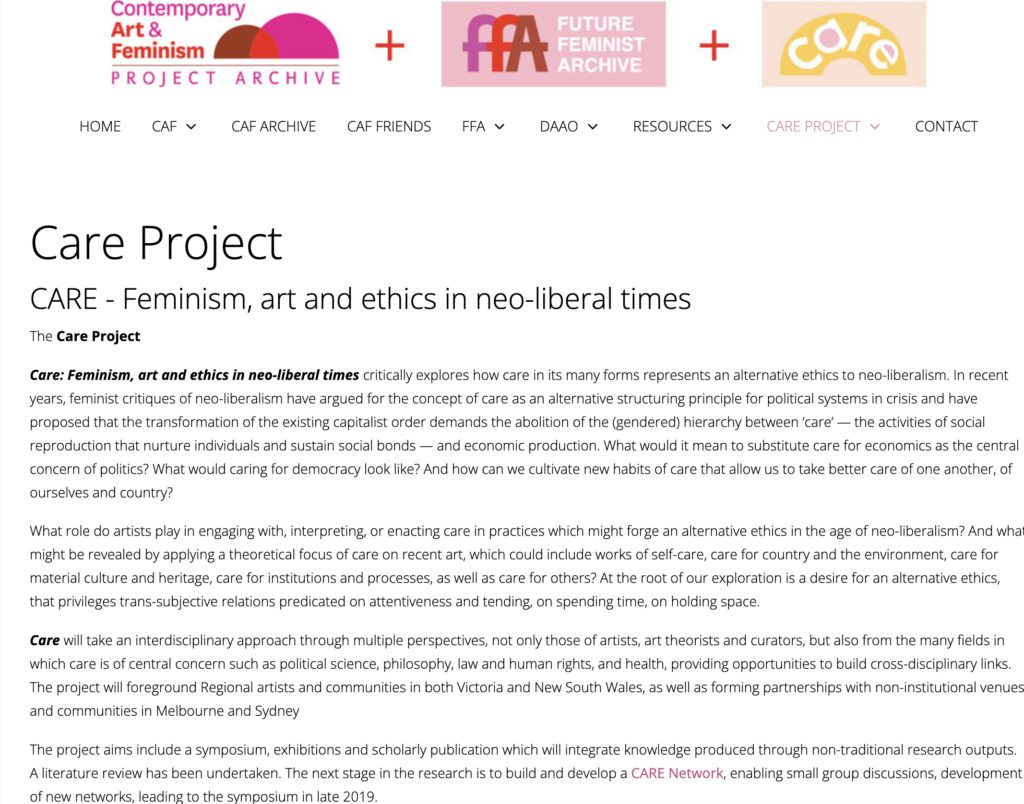Following my mentor’s advice on my project, I reflected that engaging women’s organizations and communities could enhance the real-world impact and sustainability of my exhibition.
How the Care Project Informed My Perspective on Space, Community, and Human Connection
The “Care” project recommended by JL views curating as a collaborative and caring process. It focuses not on the “outcome” but on the relationships co-created with communities, organisations, and women’s groups.

The Care project’s
The exhibition includes various elements—seminars, events, knowledge-sharing spaces, books, and an online database.
Through studying the Care project’s CAF Archive, I came to see exhibitions not merely as spatial displays, but as creative forms of social connection.
This inspired me to view the exhibition space as an experimental site for “co-constructing time”—not just addressing time scarcity, but exploring ways to temporarily reshape our relationship with time within the space (e.g. slowing down the pace, embracing pauses, and encouraging open interaction).
Developing a Hybrid Layout
PART 1: On-Site Collaboration with Local Women’s Groups
Locating offline exhibitions in East Asia can help strengthen the project’s local narrative and prevent the curatorial logic from being dominated by Western discourse. Collaborating with grassroots feminist groups, NGOs, or labor organizations can not only bring in lived experiences of time poverty, but also contribute to co-created exhibition content—such as testimonies, images, and site-specific artistic practices.
For instance, the Korean Women Workers Association in South Korea has long focused on “time rights” and work-life balance. Incorporating their voices into the exhibition would add greater social urgency and actionability to the project.

Collaboration Flowchart
Target Groups
- China: China Women’s University (directly affiliated to the All-China Women’s Federation) https://www.cwu.edu.cn/
- South Korea: Korean Women Workers Association: http://www.kwwnet.org, Womenlink: https://womenlink.or.kr
- Japan: Working Women’s Network (WWN): http://wwn-net.org/
- Women’s Action Network (WAN): https://wan.or.jp
PART 2: Digital Exhibition Conception
Through its digital platform, the exhibition has the potential to bring together women’s experiences of time across different cultural contexts. The juxtaposition of these diverse experiences is not intended for comparison, but rather to highlight time poverty as a global, structural gender issue and to create a dialogic framework within the exhibition.
Reference:
cafjoomla. (2015). CARE Project – Contemporary Art & Feminism Project Archive. Contemporaryartandfeminism.com. https://contemporaryartandfeminism.com/care
Wikipedia Contributors. (2024, March 4). Korean Women Workers Association. Wikipedia; Wikimedia Foundation. https://en.wikipedia.org/wiki/Korean_Women_Workers_Association


Leave a Reply